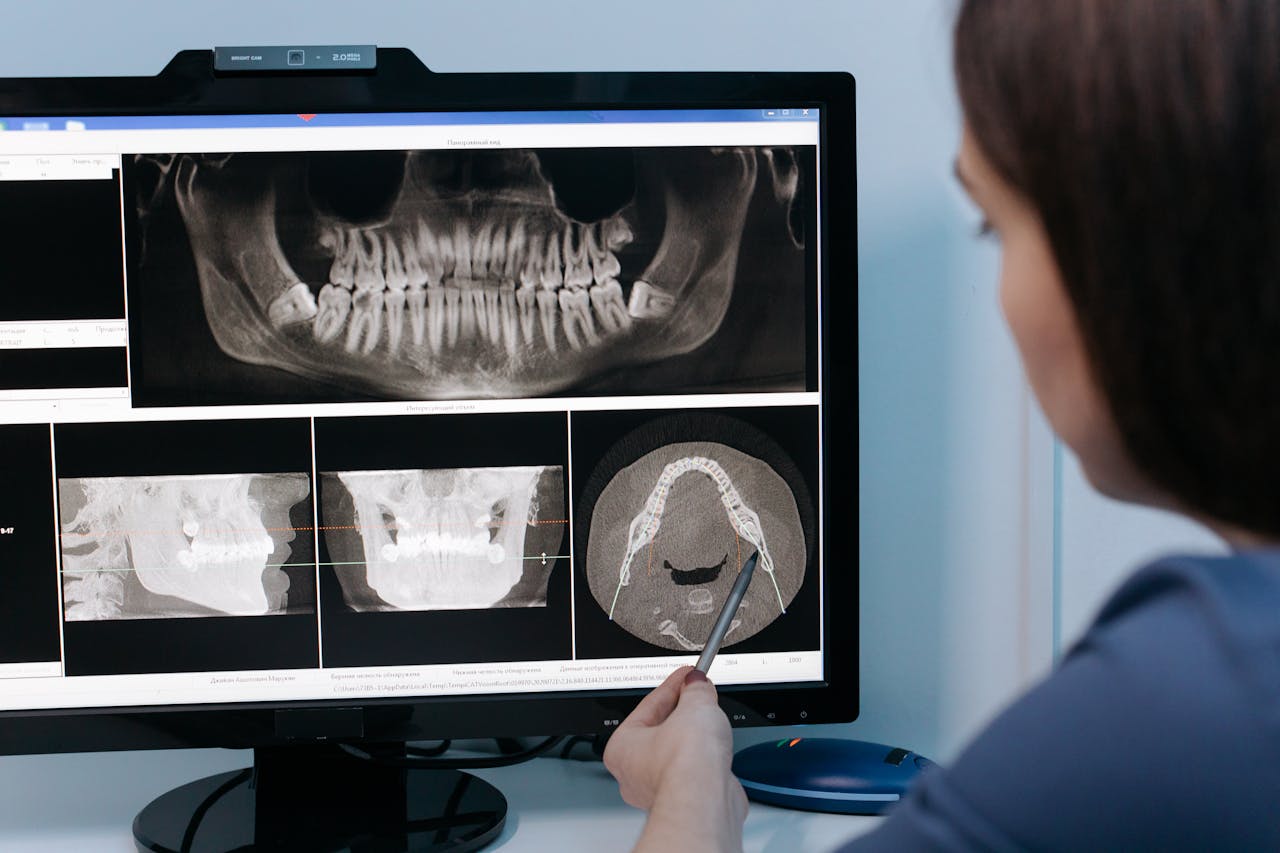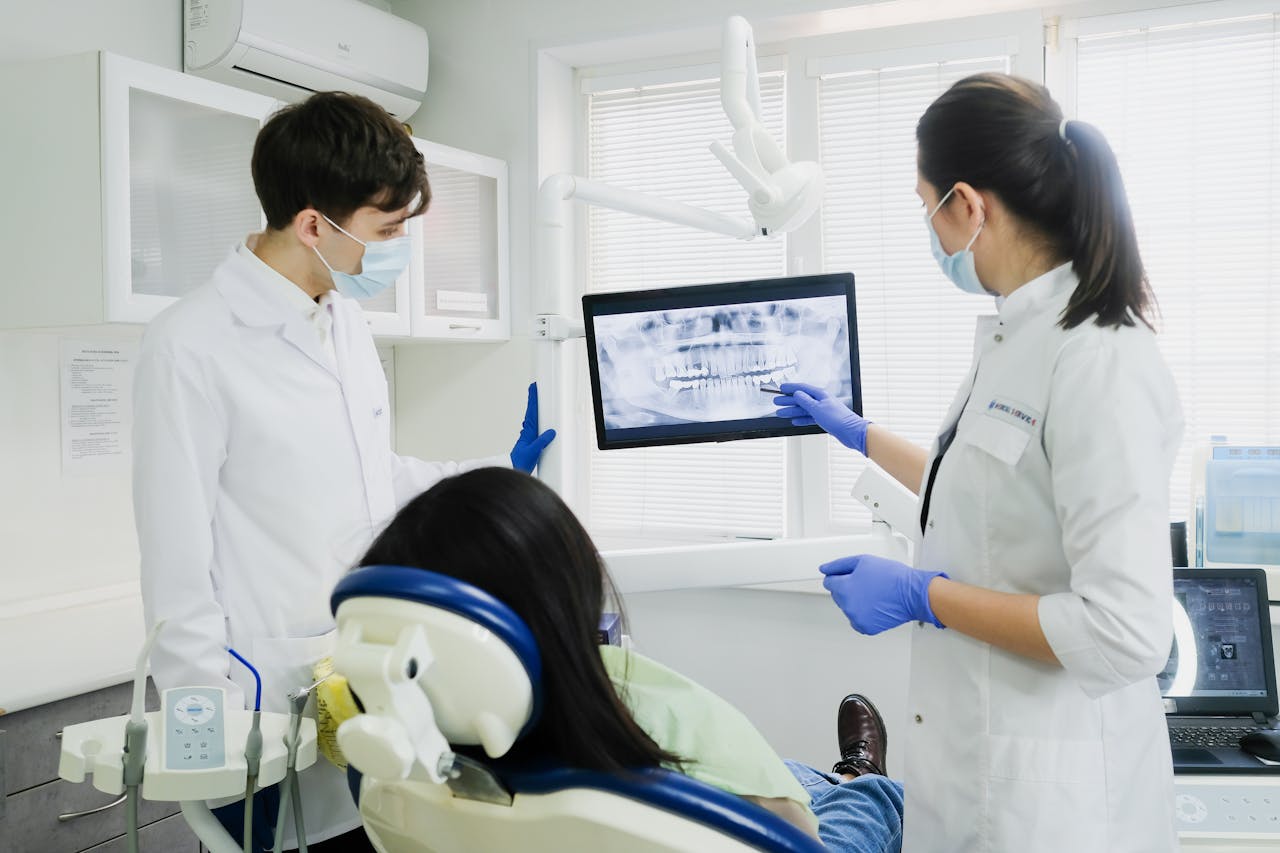50 Revenue Growth from AI Tools in Dentistry Statistics – What Every Practice Owner Should Know in 2025

Comprehensive data compiled from extensive research across dental technology vendors, clinical studies, DSO implementations, and market analysis reports
Key Takeaways
- 499% average ROI with 2.5-month payback periods - AI diagnostic tools deliver exceptional returns that dwarf traditional practice investments, making adoption a financial imperative
- $30,000 annual revenue increase per provider - Solo practitioners see substantial income gains from AI diagnostics alone, with larger practices achieving even greater multipliers
- 31% more pathologies detected, leading to billable procedures - AI uncovers missed treatment opportunities that substantially increase practice revenue
- 25-30% operational cost reduction through automation - Administrative AI eliminates hours of manual work while improving accuracy and patient satisfaction
- Market exploding from $421M to $3.1B by 2034 - The 22.3% CAGR creates massive first-mover advantages for early adopters
- Only 18% current adoption despite proven returns - Low market penetration means practices implementing now gain significant competitive advantages
- Enterprise validation with 19% production increases - Major DSOs document substantial revenue gains from AI deployment at scale
- Insurance optimization improves collections by 10-20% - AI documentation reduces claim denials and downcoding while accelerating reimbursements
Overall Market Growth & Investment
- The dental AI market is valued at $421 million in 2024, projected to reach $3.1 billion by 2034. The market demonstrates a robust 22.3% compound annual growth rate, reflecting rapid technology adoption and expanding use cases. This explosive growth trajectory positions dental AI as one of healthcare's fastest-growing technology sectors. Early adopters stand to capture disproportionate market share as the technology becomes the standard of care.
- $145 million in venture capital funding was raised by dental AI companies in 2024. This represents a $90 million increase from 2023 levels, marking the highest investment year in the sector's history. The dramatic funding surge reflects institutional confidence in AI's transformative potential for dentistry. Major investors recognize that the combination of proven ROI metrics and low current adoption creates exceptional growth opportunities.
- Pearl AI secures $58 million Series B funding, the largest single dental AI investment. The round included strategic investment from the American Dental Association, marking the ADA's first direct investment in an AI platform. This endorsement from dentistry's leading professional organization validates AI's clinical and financial benefits. The funding enables Pearl to expand from 7,000 to a targeted 20,000 practice implementations.
- VideaHealth raises $40 million in oversubscribed Series B funding. The company's rapid growth to 1,750+ practices attracted investors seeking exposure to dental technology transformation. VideaHealth's enterprise focus and FDA clearances position it for continued expansion. The oversubscription demonstrates that investor appetite exceeds available opportunities in the sector.
- Overjet's $53 million funding round sets precedent for dental AI valuations. The investment valued the company at over $500 million based on rapid DSO adoption and proven clinical outcomes. Overjet's success with major dental organizations validates enterprise-scale AI implementation. The valuation establishes benchmarks for emerging dental AI companies.
- North America commands 35% of the global dental AI market share. Regional dominance reflects advanced healthcare infrastructure and faster regulatory approvals compared to other markets. The concentration creates opportunities for technology export as international markets mature. North American practices benefit from first access to cutting-edge AI innovations.
- The Asia-Pacific region demonstrates a 45.7% CAGR, the fastest global growth rate. Markets including China, Japan, and India show accelerating adoption driven by large patient populations and modernizing healthcare systems. The rapid growth creates opportunities for established AI vendors to expand internationally. Regional partnerships enable technology transfer to emerging markets.
- Leading dental AI platforms receive FDA 510(k) clearances. Confirmed FDA clearances for Pearl, Overjet, VideaHealth, Denti.AI, ORCA, and other platforms establish clinical credibility and enable insurance reimbursement. The growing pool of FDA-cleared vendors increases competition and innovation. FDA clearance provides practitioners with confidence in safety and efficacy for patient care.
Direct Revenue Impact & ROI Metrics
- 499% average return on investment for AI diagnostic tools. Practices report payback periods under 2.5 months from improved case detection and operational efficiency. This exceptional ROI exceeds returns from traditional practice investments like equipment or marketing. The rapid payback enables practices to reinvest profits into growth initiatives.
- $30,000 average annual revenue increase per provider from diagnostic AI. Solo practitioners document consistent income gains from detecting previously missed pathologies and improving case acceptance. The revenue boost often exceeds the total annual cost of AI implementation. Multiple revenue streams compound to create sustainable practice growth.
- 19% increase in gross production per patient at GPS Dental. The DSO's enterprise-wide AI deployment generated 32% increases in crown production and recognition as a top 10% performing organization. These metrics demonstrate AI's impact scales effectively across large practice networks. Production gains directly translate to improved profitability and practice valuations.
- Significant monthly revenue increases from previously undetected pathologies. VideaHealth beta sites report capturing substantial additional revenue from treatments that would have been missed without AI assistance. The finding reveals untapped revenue potential in existing patient bases. AI enables practices to provide more comprehensive care while growing income.
- $9 return for every $1 invested in AI patient engagement tools. Automated communication systems deliver exceptional ROI through improved attendance and case acceptance. The returns compound over time as patient relationships strengthen. Engagement technology pays for itself while building practice loyalty.
- 10-25% increase in case acceptance rates with AI-assisted presentations. Visual overlays and quantified metrics help patients understand treatment needs, leading to higher acceptance of recommended procedures. The improvement stems from enhanced trust through objective diagnostic evidence. Practices report particularly strong gains in acceptance of comprehensive treatment plans.
- 31% more pathologies detected compared to manual review alone. AI assistance enables clinicians to identify significantly more treatable conditions during routine examinations. Each detected pathology represents potential revenue from necessary treatment. The compounding effect across hundreds of patients annually creates substantial income growth.
- 15% average increase in practice valuations for AI adopters. Practices with integrated AI technology command higher multiples of revenue during acquisitions or partnership negotiations. The valuation premium reflects both current performance and future growth potential. Early AI adoption creates lasting competitive advantages in practice sales.
Operational Efficiency & Cost Savings
- 25-30% reduction in operational costs through AI automation. Administrative tasks, including scheduling, billing, and charting, show dramatic efficiency improvements with AI implementation. Cost savings flow directly to bottom-line profitability. The reduction enables practices to maintain margins despite rising labor and supply costs.
- 3-4 hours daily saved by front desk staff using AI receptionists. Virtual assistants handle 70% of routine calls at 90% lower cost than traditional reception staff. Time savings allow staff to focus on higher-value patient interactions. The technology eliminates phone tag and after-hours scheduling challenges.
- 95% reduction in manual claims processing time. Revenue cycle management AI automates eligibility verification, coding, and submission with minimal human intervention. The acceleration improves cash flow while reducing billing errors. Practices report collecting payments weeks faster than manual processes.
- 1-2 hours saved daily per hygienist through AI-powered charting. Voice-activated periodontal charting and automated note generation eliminate tedious documentation. Hygienists complete 50% more charts while improving accuracy. The efficiency enables practices to see additional patients without extending hours.
- 90% decrease in utilization review administrative work. AI automation handles prior authorizations and documentation with minimal staff involvement. The reduction frees experienced staff for patient care activities. Insurance-related delays decrease significantly with automated processing.
- DSO teams manage 10-12 practices versus 5 previously. AI enables support staff to effectively double their management capacity without quality degradation. The scalability reduces per-practice overhead costs substantially. Organizations achieve growth without proportional administrative expansion.
- 15-20 minutes saved per patient through AI diagnostics. Automated image analysis and reporting accelerate clinical workflows while improving thoroughness. Time savings enable practices to increase daily patient volume. The efficiency gains compound across providers and locations.
- 11x increase in insurance eligibility verification frequency. Automated systems check coverage multiple times before appointments versus manual monthly checks. The frequency reduces claim denials from outdated information. Practices avoid treating patients with lapsed or modified coverage.
Clinical Performance & Diagnostic Accuracy
- 86-99% accuracy in caries detection with AI assistance. FDA-cleared platforms demonstrate superior performance versus the 40% accuracy of conventional X-ray interpretation. The improvement enables earlier intervention when treatments are simpler and less costly. Patients benefit from prevention-focused care while practices capture more treatment opportunities.
- 43% reduction in missed cavities using VideaHealth's platform. Clinical trials show 15% fewer false positives while dramatically improving detection rates. The accuracy prevents both under-treatment and over-treatment scenarios. Objective measurements build patient trust in treatment recommendations.
- 37% decrease in diagnostic errors when clinicians use AI support. Pearl's Second Opinion platform achieves 0.647 mean average precision across multiple pathology types. Error reduction improves patient outcomes while reducing liability exposure. The technology serves as a valuable safety net for busy practitioners.
- 96% accuracy for mandibular measurements in periodontal assessment. AI-powered periodontal evaluation shows 83% accuracy for maxillary measurements, reducing inter-examiner variability by 35%. Standardized measurements improve treatment planning consistency. The objectivity helps justify periodontal treatments to insurers.
- 86% accuracy in oral cancer lymph node detection. AI matches specialist-level performance for identifying metastatic disease in imaging studies. Early detection dramatically improves patient survival rates. The capability enables general dentists to provide enhanced cancer screening.
- 80-83% accuracy for TMJ osteoarthritis diagnosis. Machine learning algorithms match oral surgeon performance in detecting joint pathology. Accurate diagnosis guides appropriate treatment selection. The technology helps practices expand TMD service offerings.
- 8-30-second analysis time for comprehensive image review. Real-time processing enables chairside discussion of findings during appointments. Immediate results improve patient engagement and understanding. The speed maintains clinical workflow efficiency.
- 125,000+ early-stage decay cases treated with AI assistance in 2024. Heartland Dental's network documented successful intervention in previously undetected caries across 1,750 practices. Volume demonstrates AI's population health impact potential. Early detection reduces the need for complex restorative procedures.
Insurance & Reimbursement Optimization
- 10-20% reduction in downcoded insurance claims. AI-generated documentation with objective measurements and visual evidence supports coding decisions. The improvement directly increases reimbursement rates for completed work. Practices recover thousands monthly from previously downcoded procedures.
- 20% decrease in claim denials through automated verification. Real-time eligibility checking and accurate coding reduce rejection rates significantly. Lower denial rates accelerate cash flow and reduce administrative burden. The improvement compounds as staff become proficient with AI tools.
- 33% boost in collection rates using AI revenue cycle management. Automated follow-up and payment posting improve collection efficiency while reducing write-offs. The gain translates directly to practice profitability. Technology ensures no claims fall through administrative cracks.
- 100% precision in payment posting across all methods. AI eliminates manual posting errors for credit cards, checks, and electronic transfers. Accuracy reduces time spent on reconciliation and corrections. The precision improves financial reporting reliability.
- 30% additional profit from improved claims management. Comprehensive automation of billing workflows generates substantial margin improvements through efficiency and accuracy. The profit boost often exceeds gains from clinical improvements. Practices achieve financial goals without increasing patient volume.
- 10% improvement in overall collection rates. AI documentation and follow-up systems ensure maximum reimbursement for completed procedures. The improvement represents pure profit on existing production. Consistent collection performance stabilizes practice cash flow.
- 2-3 week reduction in average payment cycles. Automated submission and follow-up accelerate insurance reimbursements significantly. Faster payment improves working capital and reduces financing needs. The acceleration enables practices to invest in growth initiatives.
- $15,000-30,000 annual savings on billing staff costs. Automation reduces the need for dedicated billing personnel while improving performance. Savings can be redirected to clinical staff or technology investments. The reduction helps practices manage rising labor costs.
Patient Engagement & Retention Impact
- 35% increase in patient satisfaction scores with AI implementation. Patients appreciate faster service, visual explanations, and comprehensive care enabled by AI tools. Higher satisfaction drives referrals and positive reviews. The improvement strengthens the practice's reputation and growth.
- 59% of patients are more likely to trust dentists using AI technology. Survey data shows patients view AI adoption as a sign of modern, quality care. Trust translates to higher case acceptance and loyalty. The perception advantage attracts tech-savvy patient demographics.
- 15-30% reduction in no-show rates using AI appointment management. Automated reminders and rescheduling decrease missed appointments from 20.99% to 7.07%. Each recovered appointment represents an immediate revenue opportunity. The improvement maximizes schedule productivity and profitability.
- 25% increase in case acceptance from AI-enhanced presentations. Visual overlays and objective measurements help patients understand treatment necessity. The improvement particularly benefits comprehensive treatment planning. Higher acceptance rates accelerate practice growth.
- 70% of routine patient calls are handled by AI without human intervention. Virtual receptionists manage scheduling, confirmations, and basic questions automatically. The automation improves patient access while reducing staff workload. 24/7 availability enhances patient convenience and satisfaction.
- 2x higher engagement rates for AI-personalized communications. Targeted messaging based on patient history and preferences improves response rates. Personalization strengthens patient relationships over time. The engagement drives treatment compliance and retention.
- 40% reduction in patient wait times through operational efficiency. AI scheduling and workflow optimization minimize delays and bottlenecks. Shorter waits improve satisfaction and enable higher daily volume. The efficiency creates capacity for growth without facility expansion.
- 18% increase in patient retention rates with AI engagement tools. Automated follow-up and personalized care strengthen long-term patient relationships. Retention improvements compound over the years to build practice value. Loyal patients generate higher lifetime revenue.
Adoption Rates & Market Penetration
- Only 18% of US dental practices currently use AI technology. Despite proven benefits, adoption remains in early stages, creating first-mover advantages. Low penetration means minimal competition for AI-enabled practices. Early adopters can establish market leadership positions.
- 77% of AI-adopting dentists report positive ROI within 12 months. The majority achieve profitability quickly, with many seeing returns in under 90 days. Rapid payback reduces implementation risk substantially. Success rates encourage continued investment and expansion.
- 35% adoption rate projected by 2027 across US practices. Market penetration will double in three years as technology matures and costs decrease. The growth curve suggests 2025-2026 represents optimal entry timing. Late adopters will face saturated competitive landscapes.
- Enterprise adoption leads with 65% of large DSOs implementing AI. Major organizations like Heartland, Dental Care Alliance, and GPS Dental drive industry transformation. DSO validation accelerates independent practice adoption. The trend establishes AI as the standard of care.
- Urban practices show 3x higher adoption than rural locations. Technology infrastructure and patient expectations drive metropolitan implementation rates. Rural practices achieve implementation report higher relative ROI. The gap creates opportunities for rural competitive differentiation.
- 50% of dental schools now incorporate AI in their curriculum. Academic integration ensures that new graduates expect AI tools in practice settings. Educational adoption accelerates generational technology shift. Students trained on AI become implementation champions.
- Investment costs as low as $199-299 per provider monthly. Leading chairside AI platforms like Dentrix Detect AI offer SaaS pricing in the hundreds of dollars per provider per month. Additional costs for hardware and training vary by practice needs. ROI typically justifies investment within the first year through revenue gains and efficiency improvements.
- 92% of practices plan AI investment within 24 months. Survey data indicates widespread recognition of AI necessity for competitive positioning. The planned adoption surge will accelerate market transformation. Current adopters gain maximum advantage before saturation.
Frequently Asked Questions
Q: What's the real ROI timeline for AI implementation in a dental practice? Most practices achieve positive ROI within 2.5 months, with 77% reporting profitability within 12 months. The 499% average return includes revenue gains from improved diagnostics ($30,000 annually per provider), operational savings (25-30% cost reduction), and enhanced collections (10-20% improvement). With SaaS pricing starting at $199-299 per provider monthly, payback comes through a combination of new revenue streams and cost reductions.
Q: How does practice size affect AI implementation success? Solo practitioners see average gains of $30,000 annually, while large DSOs like GPS Dental report 19% production increases per patient. Smaller practices often achieve higher relative ROI due to greater efficiency gains from baseline, though enterprises benefit from economies of scale. DSOs successfully manage 10-12 practices with teams that previously handled 5, effectively doubling capacity.
Q: Which AI applications generate the fastest returns? Diagnostic AI provides immediate returns through 31% more pathology detection, generating substantial monthly revenue increases for practices. Administrative automation saves 3-4 hours daily for front desk staff with a 2-3 month payback. Insurance optimization reduces denials by 20% and downcoding by 10-20%, improving collections within 30-60 days of implementation.
Q: What are the biggest implementation challenges and solutions? Initial costs are manageable with SaaS pricing at $199-299 per provider monthly. Staff training requires time investment plus a 2-4 week adaptation period, managed through vendor support and champion programs. Integration with existing systems takes 30-90 days, but modern platforms offer turnkey compatibility with major practice management software.
Q: How does AI adoption affect practice valuation? AI-enabled practices command 15% higher valuations, with urban practices achieving 85-100% of collections versus 50-66% for rural non-AI practices. The premium reflects both current performance improvements and future growth potential. Buyers recognize AI adoption as a competitive differentiator that protects market position.
Q: What's the current competitive landscape for practices without AI? With only 18% current adoption, non-AI practices still compete effectively but face increasing pressure. However, 92% of practices plan implementation within 24 months, suggesting the window for competitive advantage is closing rapidly. Early adopters establish market leadership, while late adopters will struggle to differentiate in saturated markets.
Q: How do insurance companies view AI-diagnosed treatments? FDA clearance for leading platforms, including Pearl, Overjet, VideaHealth, Denti.AI, and ORCA, establishes reimbursement eligibility. AI documentation with objective measurements reduces downcoding by 10-20% and denials by 20%. Insurers increasingly prefer AI-supported claims due to standardized criteria and visual evidence, accelerating approvals and payments by 2-3 weeks.
Sources Used
- InsightAce Analytic - AI in Dentistry Market Report
- HealthfulHelps - AI and Dentistry Usage Statistics 2024
- Open & Affordable Dental - 50 AI Statistics
- Becker's Dental - Venture Capital Funding Report
- VideaHealth - Company News and Case Studies
- Overjet - AI Applications and ROI Guides
- Pearl AI - Patterson Dental Partnership
- Dentrix - AI ROI Calculator
- TrueLark - DSO AI Implementation Studies (content referenced without link)
- Thoughtful.ai - Revenue Cycle Management
- Dental Economics - AI Industry Analysis
- Harvard School of Dental Medicine - AI in Education
- American Dental Association - Industry Reports
- Denti.AI - Clinical Automation Platform
- Business Wire - Funding Announcements









